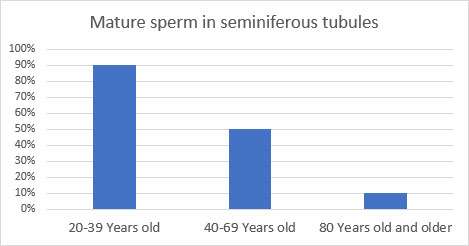Virility
Virility (from the Latin virilitas, manhood or virility, derived from Latin vir, man) refers to any of a wide range of masculine characteristics viewed positively. Virile means "marked by strength or force".[2] Virility is commonly associated with vigour, health, sturdiness, and constitution, especially in the fathering of children. In this last sense, virility is to men as fertility is to women. Virile has become obsolete in referring to a "nubile" young woman, or "a maid that is Marriageable or ripe for a Husband, or Virill".[3]
| Look up virility in Wiktionary, the free dictionary. |

Historically, masculine attributes such as beard growth have been seen as signs of virility and leadership (for example in ancient Egypt and Greece).[1]
Male virility
Evidence shows that increased male age is associated with a decline in semen volume, sperm motility, and sperm morphology.[4] In studies that controlled for female age, comparisons between men under 30 and men over 50 found relative decreases in pregnancy rates between 23% and 38%.[4]
Sperm count declines with age, with men aged 50–80 years producing sperm at an average rate of 75% compared with men aged 20–50 years. However, an even larger difference is seen in how many of the seminiferous tubules in the testes contain mature sperm;
- In males 20–39 years old, 90% of the seminiferous tubules contain mature sperm
- In males 40–69 years old, 50% of the seminiferous tubules contain mature sperm
- In males 80 years old and older, 10% of the seminiferous tubules contain mature sperm[5]

Research shows increased risks for health problems for children of older fathers. A large-scale Israeli study found that the children of men who were 40 or older were 5.75 times more likely than children of men under 30 to have an autism spectrum disorder, controlling for year of birth, socioeconomic status, and maternal age.[6] Increased paternal age has also been correlated to schizophrenia in numerous studies.[7][8][9]
Researchers have found evidence to suggest overweight obesity may cause subtle damage to sperm and prevent healthy pregnancy. They say fertilization was 40% less likely to succeed when the father was overweight.[10]
The American Fertility Society recommends an age limit for sperm donors of 50 years or less,[11] and many fertility clinics in the United Kingdom will not accept donations from men over 40 or 45 years of age.[12] In part because of this fact, more women are now using a take-home baby rate calculator to estimate their chances of success following invitro fertilization.[13]
See also
- Fertility
- Muliebrity
- Machismo
- Masculinity
- Physical strength
- Virilization
- Virtus (virtue)
- Vīrya (Hinduism) (Sanskrit term for the same)
References
- Schiebinger 1993
- Oxford English Dictionary
- Oxford English Dictionary
- Kidd, S. A., Eskenazi, B., Wyrobek, A. J. (February 2001). "Effects of male age on semen quality and fertility: a review of the literature". Fertil. Steril. 75 (2): 237–48. doi:10.1016/S0015-0282(00)01679-4. PMID 11172821.CS1 maint: multiple names: authors list (link)
- " Effect of Age on Male Fertility" Seminars in Reproductive Endocrinology. Volume, Number 3, August 1991. Sherman J. Silber, M.D.
- Reichenberg, A., Gross R., Weiser M., et al. (September 2006). "Advancing paternal age and autism". Arch. Gen. Psychiatry. 63 (9): 1026–32. doi:10.1001/archpsyc.63.9.1026. PMID 16953005.
- Malaspina, D.; Harlap S.; Fennig S.; et al. (April 2001). "Advancing paternal age and the risk of schizophrenia". Arch. Gen. Psychiatry. 58 (4): 361–7. doi:10.1001/archpsyc.58.4.361. PMID 11296097.
- Sipos A, Rasmussen F, Harrison G, et al. (November 2004). "Paternal age and schizophrenia: a population based cohort study". BMJ. 329 (7474): 1070. doi:10.1136/bmj.38243.672396.55. PMC 526116. PMID 15501901.
- Malaspina D, Corcoran C, Fahim C., et al. (April 2002). "Paternal Age and Sporadic Schizophrenia: Evidence for De Novo Mutations". Am. J. Med. Genet. 114 (3): 299–303. doi:10.1002/ajmg.1701. PMC 2982144. PMID 11920852.
- "Obesity | Fat men linked to low fertility". Sydney Morning Herald. 18 October 2010. Retrieved 19 October 2010.
- Plas, E., Berger, P., Hermann, M., Pflüger, H. (August 2000). "Effects of aging on male fertility?". Experimental Gerontology. 35 (5): 543–51. doi:10.1016/S0531-5565(00)00120-0. PMID 10978677.CS1 maint: multiple names: authors list (link)
- "Age Limit of Sperm Donors in the United Kingdom", PDF file
- "ForMyOdds.COM". ForMyOdds.COM. Retrieved 25 September 2014.
Further reading
- Schiebinger, Londa (1993), Nature's Body, Boston, Massachusetts: Beacon Press